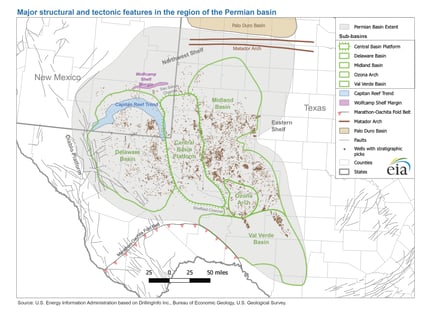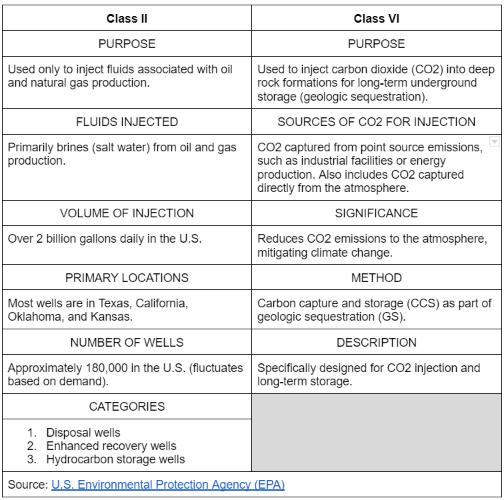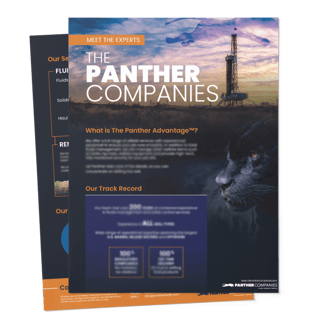In an era where industries worldwide are amplifying efforts to reduce their carbon footprints, carbon sequestration stands out as a critical weapon in the arsenal for heavy industry and energy producers. The imperative to transition to greener, sustainable solutions is pressing.
Situated at this crossroads, the Permian Basin—endowed with its unique geological attributes and prime geographical positioning—stands out as a frontrunner in the carbon sequestration frontier. This blog will spotlight carbon initiatives that highlight the Permian’s leadership and transformative capabilities. Let’s delve into some of the groundbreaking projects making waves in the oil and gas industry.
Milestone Carbon's Development in the Midland
 Milestone Carbon, a branch of Milestone Environmental Services, is an example of a company leading the way in carbon sequestration solutions for industrial emissions in the Permian. Their newest project is a CO2 storage hub in the Midland Basin, covering Upton and Midland counties in West Texas. The endeavor even caught the attention of SK Capital Partners, a New York-based private investment firm, which recently acquired Milestone.
Milestone Carbon, a branch of Milestone Environmental Services, is an example of a company leading the way in carbon sequestration solutions for industrial emissions in the Permian. Their newest project is a CO2 storage hub in the Midland Basin, covering Upton and Midland counties in West Texas. The endeavor even caught the attention of SK Capital Partners, a New York-based private investment firm, which recently acquired Milestone.
Key Developments of the Carbon Sequestration Hub
- Land Acquisition: Milestone Carbon has acquired rights to 10,000 acres in Upton and Midland counties. This land is earmarked for permanent CO2 storage.
- Permits for Injection Wells:
- The company holds a Class II injection well permit from the Texas Railroad Commission. This allows for CO2 sequestration from local natural gas processors.
- A Class VI injection well permit application is in the works. This will enhance their capacity to capture CO2 from various industrial sources

- Storage Potential: The Midland Basin hub can store up to 30 million metric tons of CO2—comparable to a year’s emissions from 6.5 million U.S. vehicles.
Why This Matters: Impact on Permian Basin, Industry, and Energy
Carbon sequestration in the Permian Basin symbolizes more than technological progress; it’s an emblem of a shifting paradigm toward sustainability in the energy sector. By capturing and storing CO2, significant benefits are reaped for both the environment and the economy:
- Carbon Footprint: Carbon sequestration offers a pivotal solution for heavy industries and energy producers. By reducing carbon footprints, it aids sectors, including natural gas processing and power generation, in transitioning to greener operations. This method not only curbs current carbon emissions but also sets the foundation for future eco-friendly innovations.
- Economic Boost: The rise of carbon capture and storage (CCS) facilities heralds new employment opportunities. From construction to management, a range of jobs are poised to be created, contributing to the region’s economic vigor.
- Innovation Magnet: The move toward carbon sequestration signals an open door for green tech advancements. As CCS hubs become more prevalent, they can serve as incubators for pioneering eco-technologies and products.
The introduction of carbon hubs, particularly like the one in the Midland Basin, is more than just a technological leap. It’s a promising and practical solution for industries aiming to offset their carbon footprint while continuing to thrive in a progressively eco-conscious market. With this landscape in mind, it becomes essential to understand the inherent attributes of the Permian Basin that make it an ideal choice for these endeavors.
The Permian Basin: A Hub of Carbon Sequestration Potential
The Permian Basin, a region that stretches across southeast New Mexico and West Texas, stands at the forefront of underground carbon storage opportunities. While the basin has seen substantial oilfield activity over the years, its unique geological attributes position it as a leader in the future of carbon sequestration.
Harnessing the Permian’s Sequestration Potential
Recent advancements in geoscience have spotlighted the Permian Basin’s potential for carbon sequestration. Several factors make this region particularly promising:
Historical Hydrocarbon Production
Areas like the northern Delaware Basin, with a legacy of heavy oil and gas extraction, have seen a depletion in pressure over time, resulting in increased geological stability. This makes them ideal candidates for storing carbon securely underground.
Geological Resilience
Scientists have identified that the pre-drilled rocks in the Delaware Basin exhibit lower seismic pressure, reducing the risk of high-magnitude earthquakes when introducing fluids or gases.
Mark Zoback, a Stanford scientist, reiterates the importance of this geological advantage. He underscores that safely storing vast volumes of CO2 is a global challenge, and the Permian Basin’s attributes can be pivotal in addressing it.
As the world pivots toward sustainable energy practices, the Permian Basin’s transformation from an oil-producing giant to a potential leader in carbon storage showcases its pivotal role in shaping a greener, more sustainable future for the energy industry.
Other Notable Carbon Initiatives in the Permian Basin
Building on this transformative momentum, numerous companies in the Permian Basin are harnessing innovative technologies and forging strategic collaborations. Their actions highlight an unwavering commitment to environmental stewardship. Let’s delve deeper into these game-changing developments:
Occidental Petroleum’s Direct Air Capture Plant
 Occidental Petroleum is spearheading the construction of Stratos, set to be the world’s premier Direct Air Capture (DAC) plant, located in Ector County, Texas.
Occidental Petroleum is spearheading the construction of Stratos, set to be the world’s premier Direct Air Capture (DAC) plant, located in Ector County, Texas.
Key Insights:
- Operational Timeline: Slated for a mid-2025 launch, the Stratos facility marks a significant leap in carbon capture technology.
- Significance: Stratos epitomizes the evolving landscape of industries proactively working to counterbalance their carbon footprint, contributing tangibly to global net-zero aspirations.
Ozona CCS LLC’s CO2 Business Strategy
Ozona CCS LLC launched an ambitious plan to set up one of the inaugural commercial carbon dioxide (CO2) sequestration wells in the Permian Basin.
Key Insights:
- Partnership: The San Antonio-based firm inked a definitive agreement with Texas Pacific Land Corp. to lease over 5,000 acres for drilling.
- Strategic Focus: This endeavor exemplifies Ozona’s mission to present end-to-end solutions for CO2 capture, transport, and sequestration, primarily targeting the Permian Basin and the Texas Gulf Coast.
As stated by Richard Adams, Co-CEO of Ozona, this pioneering project underscores the industry’s prowess in atmospheric carbon dioxide reduction.
Stakeholder Midstream’s Landmark Injection Well
The U.S. Environmental Protection Agency (EPA) granted a notable approval to Stakeholder Midstream for its Monitoring, Reporting, and Verification (MRV) plan, supporting the permanent sequestration of carbon dioxide (CO2) at the Pozo Acido injection well.
Located in the Permian Basin near the Texas-New Mexico border, the injection well distinguishes itself as the first in Texas to secure EPA validation for CO2 sequestration without the integration of enhanced oil recovery (EOR) techniques. This development reflects a strategic shift toward advanced carbon and emissions management.
Key Insights:
- Unprecedented EPA Approval: Pozo Acido is the first well of its kind in Texas to receive the EPA’s sanction for CO2 sequestration without EOR.
- Strategic Positioning: Located in the resource-rich Permian Basin, facilitating third parties in the region to align with eco-conscious goals.
- ESG Commitment: As articulated by Stakeholder’s Chief Commercial Officer, Brett Baker, this endeavor showcases a tangible commitment to ESG principles, setting the bar high for oil and gas industries.
While several players are making notable strides in the Permian Basin, certain companies are setting themselves apart with specialized services and holistic solutions tailored to meet the industry’s evolving needs.
Crafting Sustainable Solutions: The Panther Advantage™
Integrated solutions are pivotal in advancing carbon sequestration projects, especially for heavy industry and energy producers. In this space, The Panther Companies stand out with our comprehensive expertise in drilling fluids, solids control equipment, haul-off, disposal services, and cutting-edge engineering. With hands-on experience in the most active basins in the U.S., Panther experts are proficient at navigating unique drilling challenges, including for carbon sequestration wells.
 Panther’s ability to devise all-inclusive fluid management systems aligns perfectly with industrial sectors seeking sustainable emission solutions. Whether it’s the Permian Basin’s common challenges like mud losses or bit balling, our solutions minimize operational inefficiencies and promote sustainable drilling practices.
Panther’s ability to devise all-inclusive fluid management systems aligns perfectly with industrial sectors seeking sustainable emission solutions. Whether it’s the Permian Basin’s common challenges like mud losses or bit balling, our solutions minimize operational inefficiencies and promote sustainable drilling practices.
Contact the Big Cats Today
For a more sustainable future in the energy and heavy industry sectors, it’s imperative to collaborate with experts. Reach out to The Panther Companies to delve deeper into our offerings and expertise, and witness Panther’s unwavering commitment to a sustainable industry future.

